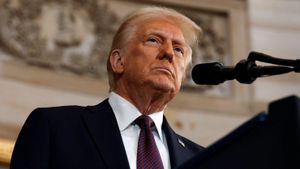President-elect Donald Trump is sending strong signals of discontent toward the BRICS coalition, comprised of Brazil, Russia, India, China, South Africa, and now featuring several new members. His recent threats have stirred up controversy and raised eyebrows at international gatherings, where discussions pivoted around the creation of alternative currencies to the dominant U.S. dollar. The crux of Trump's message? An unyielding stance against what he considers potential economic sabotage by these nations.
On November 30, Trump took to his Truth Social platform, warning BRICS members against forming or supporting any currency initiatives intended to replace the dollar. He stated, “The idea of the BRICS Countries trying to move away from the Dollar is OVER. We require a commitment from these Countries...” Trump then explicitly threatened 100% tariffs on goods from any country involved, declaring they should “say goodbye to selling” to the United States.
This stern admonition isn't merely bluster—it echoes a broader US foreign policy strategy aimed at maintaining the dollar's dominance as the world’s primary reserve currency. At present, the U.S. dollar constitutes approximately 60% of global foreign exchange reserves, making it the backbone of international trade. While BRICS nations have been vocal about their frustrations with American hegemony over the financial system, key players within BRICS have observed Trump’s threats with growing concern.
Throughout the year, BRICS has ramped up efforts toward de-dollarization, which involves creating alternative means of settling trade without relying heavily on the U.S. dollar. This initiative gained significant traction during their recent summit where members explored measures like utilizing local currencies and blockchain technologies. The group aims to loosen the traditional grip of the dollar and mitigate the impact of U.S.-imposed economic sanctions.
Notably, Russian President Vladimir Putin has been candid about the need for structural changes. He characterized the dollar's dominance as the “weaponization” of money, arguing it forces many nations to seek out alternatives. “We are forced to search for alternatives,” he declared, reflecting BRICS countries' frustrations and their commitment to greater autonomy.
Adding fuel to the fire, BRICS recently expanded its membership to include Iran, Saudi Arabia, the United Arab Emirates, Ethiopia, and Egypt, with around 34 nations expressing interest. This growth signal potential shifts in global economic power dynamics, which may pose challenges for U.S. financial interests abroad. Such developments make Trump's threats all the more pertinent, as he amplifies calls to stand firm against movements seen as challenging U.S. global economic hegemony.
With discussions about tangible alternatives to the dollar gaining momentum within the BRICS framework, market analysts have posited potential scenarios where these nations could effectively bypass U.S. sanctions—an initiative deemed ambitious, yet not impossible. The proposed solutions include creating payment systems to replace the well-established SWIFT network, which has historically anchored international banking operations.
Yet, not all analysts agree on the feasibility or immediacy of detaching from the U.S. dollar. According to experts, even with various efforts, the dollar still holds a formidable position and continues to dominate as the primary global reserve currency. An Atlantic Council model assessing the dollar's status indicates it remains “secure in the near and medium term.”
Trump’s rhetoric suggests he plans to hold firm against perceived economic encroachments. His approach mirrors past actions where tariffs were used strategically to exert pressure on nations, including previous threats of tariffs against Mexico and Canada, which he leveraged to extract concessions on immigration policies. The unmistakable pattern reveals Trump's willingness to escalate economic tensions as he positions himself firmly as protector of U.S. economic interests.
Therefore, as nations within BRICS gear up for what could become protracted negotiations about their collective economic future, they must also weigh Trump's potential tariffs against their aspirations for greater independence from the dollar. International observers are left pondering—could Trump's administration hinder BRICS' ambitious currency plans? Or will this be another chapter of diplomatic tit-for-tat?
Only time will tell how this standoff will influence currency markets or drive breakthrough innovations aimed at establishing new international trade dynamics. Nevertheless, as Trump finesses his message with threats of punitive tariffs, the world watches, weighing the lasting impacts of his administration’s fiery rhetoric on global currency strategies.



